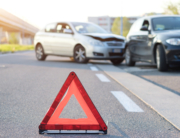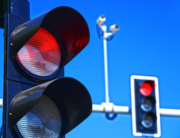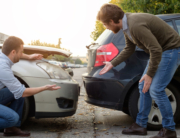In the case of a rear-end collision involving three cars, the party who is at fault under FL § 768.81 will depend on the facts of your situation. Any of the three cars can be negligent, leading to the crash. Sometimes more than one of the drivers is at fault. It is even possible for someone who was not in one of the vehicles to cause the collision.
Liability of the Back Car for a Three-Car Rear-End Collision
The typical assumption is that the last vehicle, the one in back, caused the three-car pileup, but that conclusion is not always correct. You have to look to the sequence of events that lead up to the crash to determine fault in a rear-end collision involving three cars.
The driver of the car in the back can cause a three-car rear-end collision by failing to operate his vehicle in a manner that allows him to stop in time to avoid hitting the car in front of him, which, in a three-car crash, is the middle vehicle. Negligent conduct by the driver of the back car can include:
- Tailgating
- Speeding
- Driving recklessly, like changing lanes frequently
- Failure to keep a proper lookout for things that might lead to a slowdown of the cars ahead of him, like road construction or traffic signals
- Distracted driving is defined by the National Highway Traffic and Safety Administration (NHTSA) as because he is doing things like texting, using his cell phone, changing the radio station, using the navigation system, or picking up an object from the floor of his vehicle
These are but a few examples of the scenarios in which the car in the back can be liable for a rear-end collision that involves three vehicles.
How the Middle Vehicle Can Cause a Three-Car Rear-End Collision
If the driver of the middle vehicle is engaging in any of the careless behaviors listed above, she can cause the crash. If she was not inattentive or speeding, she might have been following the lead car too closely. Many jurisdictions will automatically issue a ticket to the middle driver, even if the vehicle in the back pushed her into the front car.
When the Front Vehicle Causes a Three-Car Rear-End Crash
The driver in front is usually not the at-fault party in a three-car rear-end collision, but there are circumstances in which the driver of the lead vehicle can be responsible for the crash. Let’s say that the driver of the front car was not paying attention when he suddenly noticed that the upcoming traffic signal was red.
He slammed on the brakes, trying to avoid pedestrians in the crosswalk and cars going through the intersection with the green light. As a result, the two vehicles behind him could not stop in time, and they ran into the rear-end of the car in front. In this case, the driver in front was liable for the crash.
This example also illustrates how more than one driver can be at fault in a rear-end collision involving three cars. The drivers of the middle and back vehicles might be guilty of negligence in addition to the driver of the front car. The middle and back drivers might have been engaging in careless conduct like:
- Distracted driving
- Driving too fast for the circumstances
- Tailgating
If a third party causes the wreck, that person can be at fault in a rear-end collision involving three cars. For example, a bicyclist comes flying out of a blind alley into a street without looking. A car brakes suddenly to try to avoid hitting the bike. The two vehicles behind the car slam into the back of the lead vehicle. The bicycle rider can be liable for the collision.
The bottom line is that whoever was negligent and caused the wreck can be liable for the collision, even if that means that more than one person bears responsibility.
Call the Montero Law Center today at (954) 767-6500 for a free consultation.
 English
English  Español
Español 





